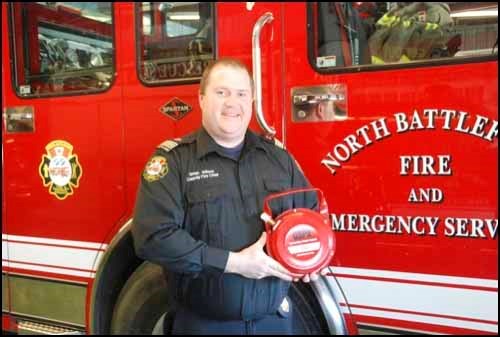North Battleford Fire and Emergency Services have a new tool at their disposal in their efforts to battle major fires.
The tool is called a Dry Sprinkler Powder Aerosol - 5, or DSPA-5. North Battleford is the first fire department in Saskatchewan to have this tool in its arsenal.
It is a canister about the size of a pie plate and weighs about 4.5 kilograms (10 pounds), but when deployed it can reduce the amount of heat at a fire scene by as much as 700 F.
North Battleford is leading the way for introduction of the use of the device in Saskatchewan. It has been used in a few other jurisdictions, particularly in Europe, and there have also been a number of successful deployments in Ontario by fire departments.
Deputy Chief Brian Wilson showed off the new equipment to the News-Optimist at the fire station Thursday.
"It's designed as an augmentation to traditional firefighting tools," said Wilson.
The canister is thrown into a burning structure just prior to firefighters entering the building, emitting a dry-powder aerosol consisting of potassium nitrate.
That aerosol absorbs heat and cools the burning fuel, and disrupts the chemical chain reaction without affecting the oxygen levels.
The DSPA-5 is particularly useful because it makes it easier for fire crews to enter a burning building.
Deploying the device "makes it safer for our guys to enter and increases survivability for persons inside the structure. And it drastically reduces the amount of water used to extinguish the fire, so it's a win-win for property owners and firefighters."
Fire Chief Pat MacIsaac is enthusiastic about what this new item will be able to do in aiding efforts to fight fires.
He describes it as a "tool that is going to reduce the risk to our firefighters, it's going to enhance survivability for victims and reduce property damage. I think we need to explore all those possibilities, and make the best use of it."
The new unit has been with the fire department for about a month. Last month MacIsaac introduced the DSPA-5 to North Battleford city councillors at their municipal services meeting, describing the equipment as a new way to fight fires.
Ten of the DSPA-5 devices were offered on a consignment basis to the department through an agreement with supplier AFG Flame Guard, Ltd., so there was no initial cost to the department. They cost about $1,295 each.
Not every fire situation will call for the use of the DSPA-5. It is not likely to be used in situations where a structure is too far involved and beyond saving. Similarly, there will also be less serious fire situations, such as a pot on a stove or a malfunctioning furnace, where a fire can be easily contained without having to deploy the device.
Its most effective use will come in being deployed in a structure fire situation just before it threatens to get out of hand.
"The first arriving officer obviously has to use their own judgment when they arrive on the scene whether that particular fire is the right application for these devices," said Wilson.
Once the decision is made to deploy the device, the officer walks around the structure and sizes up where they believe the fire to be and how far the fire has progressed. Meanwhile the rest of the crew is getting the hoses laid out so they can enter the building.
The officer can then pull the fuse, which burns the dry chemical inside the device, throw it through a window or door, and the chemicals from the device would emit and start working on the components of the "fire tetrohedron," which causes fires to continue to burn.
"It's cooling the products being burned; it's absorbing heat - the ambient heat from inside the room; as well as attacking the chemical chain reaction of the fire, which helps suppress the fire and make it safer for our guys to enter," said Wilson.
He says this new device will be ideal for basement fires, attic fires and other hard-to-reach fires that are challenging for crews. MacIsaac adds these fires are also particularly dangerous because they are in confined areas, so deploying the DSPA-5 should help reduce the risk.
Also, by reducing the surrounding heat, MacIsaac says the tool will be beneficial in reducing or eliminating the risk of "backdraft" or "flashover" - an especially dangerous situation where heat levels become so high that all items in the room start to go on fire.
The DSPA-5 is just one more tool at the department's disposal.
"It's not a replacement for any of our traditional firefighting attack," noted Wilson, who said firefighters must still go in and use their hoses and the rest of their tools.
While the device is now part of the city's fire department the department has not yet deployed it. However, department members are trained in its use.
"I've seen one used in a simulated fire that we did back in Ontario before I came out here, so I've seen one used in that scenario but not yet in a live incident. Hopefully, we won't have any fires," said Wilson.
MacIsaac notes that other fire departments in the province are closely watching North Battleford to see what its experience will be with the DSPA-5.
"We've had other fire departments contact us and express some interest," said MacIsaac. "It is a bit of a learning curve. It's not for every fire. There's some specific applications for this device, but when those conditions come together we're thinking this device is going to be very effective."




